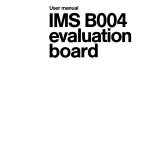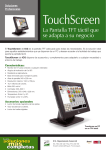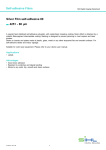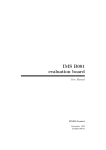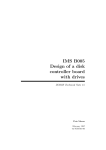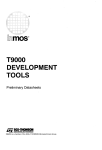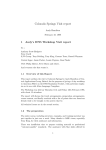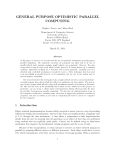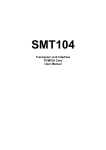Download SMT103-ICG - ClassicCMP
Transcript
SMT103-ICG User Manual Version 1.0 Provisional Draft Document: Product Name: Author: SMT103-ICG User Guide.doc User Manual Mark Ainsworth Issue : 01 Revision Date: Original Date: Rev.: 1.11 9 September 1998 3 April 1997 Disclaimer Every effort has been made to ensure the accuracy of this document, however the manufacturer cannot accept responsibility for any loss or damage caused as a result of using this document. Notice of any mistakes, inconsistencies or comments relating to this document would be gratefully received by fax or email to Sundance. Fax No. +44 (0)1494 726363 email [email protected] Technical Support Technical support is available by the following methods: Telephone Fax email +44 (0)1494 431203 +44 (0) 1494 726363 [email protected] For UK users a local call line is available: Telephone 01345 626791 Sundance now operate a World Wide Web page, and information is posted on a regular basis to provide our customers with the most up to date information concerning our products. http://www.sundance.com/ Page 1 of 24 SMT103 USER MANUAL ISSUE 1 Table of Contents Table of Contents ......................................................................... 2 Table of Figures............................................................................ 3 Table of Tables ............................................................................. 4 Chapter 1 General Introduction ................................................... 5 The Manual ............................................................................. 6 Chapter 2 Installation ................................................................... 8 Prepare the Host PC and insert the board ............................... 8 Chapter 3. Fitting the TRAMs..................................................... 10 Handling Precautions ............................................................ 10 Which slot(s) to use............................................................... 10 How to fit a TRAM ................................................................. 11 Chapter 4 Using the SMT103-ICG .............................................. 12 Chapter 5 Switches..................................................................... 13 Version Selection .................................................................. 13 Transputer and TRAM Link Speed Selection ......................... 13 Transputer Clock Speed Selection......................................... 13 Transputer Memory Speed Selection..................................... 13 The Internal Reset, Analyse and Error lines........................... 13 Chapter 6. Programmable Registers.......................................... 14 Input data registers, Output data registers...................... 14 Input Status registers, Output Status registers................ 14 Error Register ................................................................ 15 Reset Register ............................................................... 15 Analyse Register............................................................ 15 Example Code ...................................................................... 16 Chapter 7. What are Reset, Analyse and Error?........................ 17 Chapter 8. Outside World Interface ........................................... 19 Bibliography ............................................................................. XXI INDEX ....................................................................................... XXII Page 2 of 24 SMT103 USER MANUAL ISSUE 1 Table of Figures TRAM slot positions................................................................... 10 Transnputer speed selection ..................................................... 13 Page 3 of 24 SMT103 USER MANUAL ISSUE 1 Table of Tables Jumper colour allocation ........................................................... 13 PC Port IO Map ........................................................................... 14 Input [output] Status Register ................................................... 15 Error Register ............................................................................. 15 Reset Register............................................................................. 15 Page 4 of 24 SMT103-ICG User Manual Issue 1 Chapter 1 General Introduction The INMOS pioneered, Parallel Processing standard is built around that of the TRAM (TRAnsputer Module) concept, which consists of a variety of module sizes. These vary from the smallest size 1 (3.66''x1.05'") to the largest size 8 (3.66'' x 8.40''). TRAMs may contain a transputer, some memory and other various I/O functions. These may include Analog to Digital converters; IEEE interfaces; SCSI controllers, and high resolution graphics devices. The TRAM format has also been used by many manufacturers to integrate sequential processors like Intel's i860 Vector processor, Motorola's 56000/96000 DSP, Zoran's Vector DSPs and AT&T's DSPs into transputer networks. The only other truly parallel processing processor, Texas Instruments TMS32C40 pDSP, has also been incorporated into a TRAM format using a size 4 board. The front-end computer host system for transputers and TRAMs span from minimum PC/XTs to high-end SUN and VAX workstations. They all have a basic common interface protocol, the INMOS AFServer, with different hardware implementations. This protocol was introduced by INMOS with their first product for the PC, the INMOS B004 PC plug-in board. The INMOS B004 standard was extended with the arrival of the TRAM concept and the INMOS B008 10-slot TRAM motherboard for the PC. The SMT103-ICG is a cost-effective TRAM motherboard, and integrated transputer system. It can take up to four size 1 TRAMs, in addition to the onboard transputer and memory system. This onboard system can support up to 16 MBytes of dynamic memory with a 25MHz transputer. Compatibility with the INMOS B004 industry standard provide the user with maximum flexibility. Highly integrated component usage on the PC interface, and extensive use of surface mount technology has enabled the SMT103-ICG to be condensed onto a board no bigger than a standard 8-bit interface card. This form factor will allow the SMT103ICG to be used in most old PC/XTs desktop computers and current generation laptop and notebook computers. It is also possible to use Page 5 of 24 SMT103-ICG User Manual Issue 1 other processor types from other manufactures if their interface matches that of TRAMs. The SMT103-ICG is manufactured by Sundance Multiprocessor Technology Limited, a high quality manufacturer of parallel processing products. It is covered by a one Year, return to factory, warranty from the date of purchase. The Manual All the sections in this manual should be read before any attempt is made to install the board. It outlines the differences between the two different configurations for this board. Figures 1and 2 show the configurations of the TRAMs and the host transputer for the two versions of the board. Both of these configurations are achieved using the same product, simply changing a PCB link achieves the changes required. 1 Slot 1 2 0 2 3 1 Host 2 0 Slot 0 3 3 1 Slot 2 2 0 0 3 1 Slot 3 0 notReset, notAnalyse and notError signals PC Figure 1: 355 Version Page 6 of 24 SMT103-ICG User Manual 3 1 Host 2 Issue 1 2 3 0 Slot 0 0 notReset, notAnalyse and notError signals PC Figure 2: 330 Version Page 7 of 24 SMT103-ICG User Manual Issue 1 Chapter 2 Installation Unpack the SMT103-ICG from its container and inspect it visually. If there is any sign of damage to the board or components then go no further, but inform the carrier and Sundance. Turn off and disconnect the power from your IBM PC-XT, AT, or clone. Consult the manual supplied with your PC for instructions on how to insert add-in circuit boards. Insert the SMT103-ICG into any convenient 8-bit card slot. Replace the PC cover or casing and reconnect the power and turn on. Observe normal anti-static handling precautions when working with all electronic circuits. If one is available, use a wrist-strap grounding system. If not, then always touch a properly grounded bare metal surface BEFORE handling any circuit. Also avoid all contact with connector pins on plug in cards and components. TRAMs can easily sustain mechanical damage, the connector pins are easily bent by misalignment with their sockets on insertion, or by dropping them. The pins are expensive to replace, and on some boards they are impossible to remove. Many TRAMs that can be purchased use surface mount technology. These types of components are fragile. They can easily be ripped off the surface of the PCB by very rough handling. Prepare the board by inserting your choice of transputer modules, connecting the links and checking the jumper settings. Prepare the Host PC and insert the board 1. Turn off the power to your PC and remove the system unit cover following the instructions supplied with your system. If in doubt, consult your dealer. 2. Select a slot in your PC. Remember that you only need to use an 8-bit slot. When you are deciding which slot to use please note that some TRAMs have a very high profile. You may not be able to place your board in a slot next to another slot that already has a board in it. Take care to ensure that the TRAMs do not foul on the underside of any existing boards. Page 8 of 24 SMT103-ICG User Manual Issue 1 3. Remove the metal blanking plate from the aperture in the system box that will hold the SMT103-ICG connector. 4. Insert the SMT103-ICG into the PC, holding it true both vertically and horizontally to avoid catching any adjacent cards. 5. Push the SMT103-ICG firmly into the PC connector. Apply careful but firm pressure to the top centre of the card. Do not press on the modules or components. 6. Replace the PC cover and reconnect the system to the power. Page 9 of 24 SMT103-ICG User Manual Issue 1 Chapter 3. Fitting the TRAMs Handling Precautions Observe normal anti-static handling precautions when working with all electronic circuits. If one is available, use a wrist-strap grounding system. If not, then always touch a properly grounded bare metal surface BEFORE handling any circuit. Also avoid all contact with connector pins on plug in cards and components. TRAMs can easily sustain mechanical damage, The gold connector pins are easily bent by misalignment with their sockets on insertion, or by dropping them. The pins are expensive to replace, and on some boards they are impossible to remove. Many TRAMs that can be purchased use surface mount technology. These types of components are fragile. They can easily be ripped off the surface of the PCB by very rough handling. Slot 0 Slot 2 Slot 1 Slot 3 Figure 3. TRAM slot positions Which slot(s) to use Please refer to figure 3 for a map of the positions, orientation and numbering of the TRAM slots. For a 355 version board then TRAMs Page 10 of 24 SMT103-ICG User Manual Issue 1 are fitted in all 4 slots. For a version 330 then only one TRAM is fitted, and this is put into slot 0. How to fit a TRAM 1. TRAMs should have a white or yellow triangle marked on the printed circuit board in the corner by pin 1. Match this up with the pin 1 triangle on the SMT103-ICG. If there is no triangle marked on the TRAM then please consult the manufacturer's manual or the board supplier. The effort may well save you damaging the TRAM. 2. Most TRAMs are supplied with extension pins fitted to the strip sockets to protect them in transit. Remove them with a small pair of pliers or tweezers and store them safely. You will need to use them if the TRAM ever has to be returned for repair. Take great care not to bend the pins soldered to the TRAM. If you are stacking one TRAM on top of another then keep the extenders in place. 3. Line up all the TRAM pins visually before inserting them in the motherboard sockets. When you are quite sure that the pins are aligned and partially inserted, the TRAM will push home with gentle but firm pressure. Removal is the reverse of fitting. The TRAMs will have to be gently levered out using a small screwdriver. Be careful not to bend the TRAM pins. Page 11 of 24 SMT103-ICG User Manual Issue 1 Chapter 4 Using the SMT103-ICG The SMT103-ICG is designed specifically for ICG Ltd, as so any use options are specific to this company. Any queries regarding the configuration and operation of this board within an ICG should be dealt with by ICG Ltd. Directly. Page 12 of 24 SMT103-ICG User Manual Issue 1 Chapter 5 Switches The SMT103-ICG has only a single link which is used to change the operation of the board. This changes the internal link configuration from that of a 355 to a 330 machine. Version Selection To switch between the two versions of the board you have to change the settings of J4. Connecting pins 1 to 2 will select a 355 variant. Connecting pins 2 to 3 will select a 330 variant. Do not change this link while the board is in a system with the power applied. The pin allocations on the connector for the ADC board will change so make sure you have the right cable fitted to the board if you change this setting. Transputer and TRAM Link Speed Selection The transputer fitted on the SMT103-ICG has four links that may be connected to other Inmos Link interfaces. The transmission speed of these four links, as well as the bus interface C011 and the TRAMs is fixed at 20 Mbits/sec Transputer Clock Speed Selection The transputer clock speed is fixed at 25MHz. Transputer Memory Speed Selection The memory speed is set at 3 cycles. This is the maximum speed allowable for DRAM. The Internal Reset, Analyse and Error lines The Reset, Analyse and Error lines connected to the onboard transputer and the TRAM sites are controlled from the PC bus interface. There is no option to change this configuration. Page 13 of 24 SMT103-ICG User Manual Issue 1 Chapter 6. Programmable Registers On the SMT103-ICG there is a set of software controllable registers. These registers are only accessible from the PC host and are used to control the operation of the board and are mapped as IO ports. They perform various control functions required for link communication, as well as allowing the user to control the status of external transputer networks Address #300 #301 #302 #303 #310 #310 #311 Register Input Data Register ( ro ) Output Data Register ( wo ) Input Status Register ( rw ) Output Status Register ( rw) Error Register ( ro ) Reset Register ( wo ) Analyse Register( wo ) Table 1. PC Port IO Map Input data registers, Output data registers These two registers are located inside the C011 chip. The functions of the input data register and output data register are fairly obvious. When the status registers indicate that they are either ready to receive valid data, or they contain valid data then the data is written to or read from these registers. Input Status registers, Output Status registers These registers are contained in the C011 chips, one set per device and indicate the status of the input and output data registers. See table 2 for further information. Page 14 of 24 SMT103-ICG User Manual rd Bit 0 Issue 1 "0" no input data [output not ready] "1" valid input data [output ready] wr Bit 1 "0" disable input [output] interrupt "1" enable input [output] interrupt Table 2. Input [output] Status Register Error Register This is a software readable port that indicates the Error status of the transputer network connected to the PCNotError line. This is a wire or of the main onboard transputer and any fitted TRAMS rd Bit 0 "0" Error false "1" Error true Table 3. Error Register Reset Register This register can be written to control the state of the PCNotReset line. This can then be used to control an external transputer network, as well as the onboard transputer and any fitted TRAMs. wr Bit 0 "0" Reset [Analyse] false "1" Reset [Analyse] true Table 4. Reset and Analyse Register Analyse Register This register can be written to control the state of the PCNotAnalyse line of the onboard transputer and any fitted TRAMs and external transputer network. Page 15 of 24 SMT103-ICG User Manual Issue 1 Example Code This is a small piece of pseudo-code to demonstrate how to access the data registers on the PC Bus. read_byte() do nothing while((read_status_port AND 1) equals 0) read in the input_data_port return the data read in write_byte() do nothing while((write_status_port AND 1) equals 0) output data to output_data_port return Page 16 of 24 SMT103-ICG User Manual Issue 1 Chapter 7. What are Reset, Analyse and Error? These three signals are used to control the operation of the transputer. Their names pretty well describe their functions in the system. The Reset line does exactly what it suggests. It is used to Reset transputers. When the signal is true, whatever transputers are connected to the signal are put into the reset state. They immediately stop processing and go into an idle state. When this signal is taken not true, how the transputer behaves will depend on the state of the Analyse line. If this line is also Not True then the transputer will initiate the boot process and then go into either the idle state and wait for a message on one of its links, or boot code from EPROM space. If the Analyse signal is true when the Reset line is taken Not True then the transputer will not perform any of the memory configuration read cycles, or any initial DRAM refresh cycles, but will enter a halted state. It will then remain in the halted state until it is told to do otherwise. For more detailed information read the Inmos T425/T805 etc. technical data sheets. The Analyse line can be used to debug transputers whilst they are operating. If the Analyse line is taken True without the Reset line being taken True as well then the transputer will try to enter a halt state. It will enter the halt state at the next descheduling point. From Analyse being taken True the transputer will halt within 3 time slice periods plus the time taken for any high priority process to complete. As much of the transputer state is saved to allow remote transputers to debug the internal state of the transputer when it was halted. After Analysing a transputer it must be Reset otherwise its state is undefined. For more detailed information read the Inmos T425/T805 etc. technical data sheets. The Error line indicates the error status of any transputer. This output from the transputer can be set either directly from software control, or as a result from performing instructions that generate error conditions. For a complete list of instructions, and how they Page 17 of 24 SMT103-ICG User Manual Issue 1 may cause error conditions refer to the Inmos T425/T805 etc. technical data sheets. Page 18 of 24 SMT103-ICG User Manual Issue 1 Chapter 8. Outside World Interface The outside world interface for the SMT103-ICG is designed specifically to interface to the ICG ADC card. The layout and signal allocations for this connector changes depending on which version of the board has been selected by the use of link jumper J4 Figure 4: 355 Version Page 19 of 24 SMT103-ICG User Manual Issue 1 Figure 5: 330 Version Page 20 of 24 SMT103-ICG User Manual Issue 1 Bibliography [1] Trevor Watson and Michel Rygol, INMOS Technical Note 18; Connecting INMOS Links. INMOS, 1987 [2] Stephen Ghee, INMOS Technical Note 11; IMS B004 IBM PC add-in board, INMOS, 1987 Bibliography XXI SMT103-ICG User Manual Issue 1 INDEX A M analyse general, 17 applications, 12 memory options, 13 memory speed, 13 O B B004 compatibility, 5 board operation, 12 board slot size, 8 D data registers, 14 DSP, 5 E error general, 17 I input data, 14 installation, 8 L link blocks, 13 link speed selection, 13 output data, 14 R registers analyse, 15 error, 15 input status, 14 output status, 14 reset, 15 reset general, 17 S software standard interface, 5 software example routines, 16 static precautions, 8 static precautions, 10 Index XXII SMT103-ICG User Manual Issue 1 T T4xx, 17 T8xx, 17 TRAM, 5 fitting order, 11 TRAM extender pins, 11 handling precautions, 10 sizes, 5 TRAM removal, 11 transputer clock speed, 13 Index XXIII
























